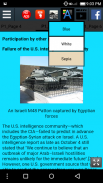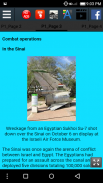








Yom Kippur War History

Описание Yom Kippur War History
The Yom Kippur War, Ramadan War, or October War (Hebrew: מלחמת יום הכיפורים, Milẖemet Yom HaKipurim, or מלחמת יום כיפור, Milẖemet Yom Kipur; Arabic: حرب أكتوبر, Ḥarb ʾUktōbar, or حرب تشرين, Ḥarb Tišrīn), also known as the 1973 Arab–Israeli War, was a war fought from October 6 to 25, 1973, by a coalition of Arab states led by Egypt and Syria against Israel. The war took place mostly in Sinai and the Golan—occupied by Israel during the 1967 Six-Day War—with some fighting in African Egypt and northern Israel.[56][57] Egypt's initial war objective was to use its military to seize a foothold on the east bank of the Suez Canal and use this to negotiate the return of the rest of Sinai.[58][59][60][61]
The war began when the Arab coalition launched a joint surprise attack on Israeli positions, on Yom Kippur, the holiest day in Judaism, which also occurred that year during the Muslim holy month of Ramadan.[62] Egyptian and Syrian forces crossed ceasefire lines to enter the Sinai Peninsula and the Golan Heights, respectively. Both the United States and the Soviet Union initiated massive resupply efforts to their respective allies during the war, and this led to a near-confrontation between the two nuclear superpowers.[63]
The war began with a massive and successful Egyptian crossing of the Suez Canal. Egyptian forces crossed the cease-fire lines, then advanced virtually unopposed into the Sinai Peninsula. After three days, Israel had mobilized most of its forces and halted the Egyptian offensive, resulting in a military stalemate. The Syrians coordinated their attack on the Golan Heights to coincide with the Egyptian offensive and initially made threatening gains into Israeli-held territory. Within three days, however, Israeli forces had pushed the Syrians back to the pre-war ceasefire lines. The Israel Defense Forces (IDF) then launched a four-day counter-offensive deep into Syria. Within a week, Israeli artillery began to shell the outskirts of Damascus, and Egyptian President Sadat began to worry about the integrity of his major ally. He believed that capturing two strategic passes located deeper in the Sinai would make his position stronger during post-war negotiations; he therefore ordered the Egyptians to go back on the offensive, but their attack was quickly repulsed. The Israelis then counter-attacked at the seam between the two Egyptian armies, crossed the Suez Canal into Egypt, and began slowly advancing southward and westward towards the city of Suez in over a week of heavy fighting that resulted in heavy casualties on both sides.[64][65]
On October 22, a United Nations–brokered ceasefire unraveled, with each side blaming the other for the breach. By October 24, the Israelis had improved their positions considerably and completed their encirclement of Egypt's Third Army and the city of Suez. This development led to tensions between the United States and the Soviet Union, and a second ceasefire was imposed cooperatively on October 25 to end the war.
The war had far-reaching implications. The Arab world had experienced humiliation in the lopsided rout of the Egyptian–Syrian–Jordanian alliance in the Six-Day War but felt psychologically vindicated by early successes in this conflict. The war led Israel to recognize that, despite impressive operational and tactical achievements on the battlefield, there was no guarantee that they would always dominate the Arab states militarily, as they had consistently through the earlier 1948 Arab–Israeli War, the Suez Crisis, and the Six-Day War. These changes paved the way for the subsequent peace process. The 1978 Camp David Accords that followed led to the return of the Sinai to Egypt and normalized relations—the first peaceful recognition of Israel by an Arab country. Egypt continued its drift away from the Soviet Union and eventually left the Soviet sphere of influence entirely.
























